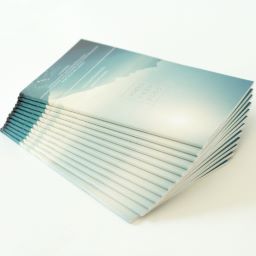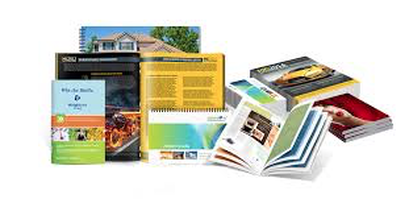A Step-by-Step Guide to Planning a Custom Booklet Printing Campaign
A Step-by-Step Guide to Planning a Custom Booklet Printing Campaign
Blog Article
The Important Overview to Comprehending Pamphlet Printing Options and Techniques
The process of booklet printing includes several considerations that can greatly impact the end product. From picking the suitable format and dimension to understanding the subtleties of binding approaches, each selection plays an essential duty. In addition, elements such as paper supply and printing strategies more affect the efficiency of the brochure. As one browses these alternatives, it comes to be essential to grasp exactly how they adjoin and what that implies for the general outcome.
Understanding Booklet Sizes and layouts
When taking into consideration brochure printing, comprehending the various styles and dimensions readily available is necessary for achieving the preferred discussion. Booklets can be generated in many formats, consisting of saddle-stitched, spiral-bound, and perfect-bound, each offering unique benefits. Typical dimensions vary from conventional letter (8.5 x 11 inches) to smaller choices like A5 (5.8 x 8.3 inches), enabling adaptability based upon web content and target audience.Selecting the ideal size can affect both the design and viewers interaction. Bigger sizes might match visually driven web content, while smaller formats might be a lot more straightforward and portable. Furthermore, the variety of pages influences the selection of binding method, as thicker pamphlets may need tougher bindings. Ultimately, recognizing these aspects permits a more customized approach, making sure that the end product aligns with the designated message and visual, boosting the total effectiveness of the interaction.
Choosing the Right Paper Stock

Binding Methods: Considerations and choices
When it involves binding approaches for booklets, numerous choices are readily available, each with distinct benefits. Saddle stitch binding provides an economical service for thinner booklets, while best binding techniques provide a more polished seek thicker publications. Wire-O binding sticks out for its resilience and simplicity of use, making it ideal for files that require flexibility.
Saddle Stitch Binding
Saddle stitch binding provides a cost-efficient and functional solution for setting up pamphlets, making it a prominent choice amongst organizations and authors. This binding approach includes folding sheets of paper in fifty percent and stapling them along the fold line, developing a neat and organized look. Typically appropriate for pamphlets with a reduced page count, saddle sewing is suitable for publications, pamphlets, and instructional materials. The simplicity of this strategy enables for fast manufacturing and is usually preferred for promotional products or short runs. It is crucial to note that saddle stitch binding might not be suitable for thicker booklets, as the spine might not hold up under raised weight. On the whole, it continues to be a trusted choice for several printing projects.
Perfect Binding Methods
Perfect binding is an extensively used strategy that gives a refined and professional finish to booklets and magazines. This technique entails gluing the web pages with each other at the back utilizing a solid adhesive, permitting a tidy side and the ability to hold a larger variety of web pages compared to saddle stitching. Perfect binding is particularly appropriate for thicker booklets, such as magazines and yearly records, where a tough, flat spine is preferred. In addition, it offers the alternative for a published cover that can be made to improve aesthetic allure. Factors to consider such as page matter, paper weight, and the meant use of the booklet must be taken right into account, as they can influence toughness and general quality.
Wire-O Binding Options
Wire-O binding, recognized for its toughness and flexibility, supplies a superb alternative for brochures that call for easy page transforming and a professional appearance. This binding method uses a series of steel loopholes that hold web pages firmly, enabling them to exist flat when open. It is especially appropriate for discussions, manuals, and directories as a result of its robust nature. Wire-O binding is available in different colors and diameters, accommodating different page counts and thicknesses. In addition, it allows the incorporation of covers and tabs, boosting the brochure's total visual. Considerations for Wire-O binding consist of the option of cable shade, the dimension of the loops, and the level of personalization desired, every one of which can exceptionally influence the end product's look and capability.
Digital vs. Offset Printing: Which Is Best for You?
When choosing a printing approach for pamphlets, recognizing the differences in between electronic and offset printing is crucial. Digital printing utilizes modern technology to produce top notch prints quickly and economically, making it optimal for brief runs or projects requiring quick turnaround times. It permits for personalization, providing the capability to print on-demand with very little waste.In comparison, offset printing is a standard approach that masters generating large quantities with regular top quality. It involves transferring ink from a plate to a rubber covering, after that to the paper, which causes dynamic shades and precise information. Nevertheless, balance out printing generally requires longer configuration times and is extra affordable for larger volumes.Ultimately, the option in between digital and counter printing relies on job needs, spending plan, and preferred quantity. For small, time-sensitive tasks, digital may be the his response finest choice, while countered might be more effective for larger, high-quality manufacturings.

Creating Your Brochure: Tips and Ideal Practices
When developing a brochure, mindful attention to format, font choice, and color use can substantially boost its performance. A well-structured format guides the reader's eye, while suitable typefaces assure readability and convey the desired tone. In addition, reliable use of shade can evoke feelings and highlight key details, making the general design extra impactful.
Choosing the Right Layout
Just how can one properly select the ideal design for a pamphlet? It is important to evaluate the pamphlet's objective and target audience. A tidy, arranged design improves readability and engagement. Using a grid system can aid in straightening aspects continually, creating a specialist look. In addition, integrating visual pecking order through differing dimensions and positionings of pictures and message can assist the visitor's eye and stress vital info. It is additionally important to leave sufficient white room, which prevents overcrowding and enables for better emphasis. Evaluating different formats via mock-ups can supply insight right into exactly how the layout executes in real-world scenarios, ensuring that the last product fulfills both functional and aesthetic needs.
Selecting Proper Typefaces
A well-chosen font can substantially improve the total design of a booklet, enhancing the design and enhancing the material's message. The option of typefaces must take into consideration readability, especially for body message, as it assures the details comes to all readers. Sans-serif fonts are frequently preferred for digital layouts, while serif fonts can lend a conventional feel in printed products. It's a good idea to Recommended Reading limit font selections to 2 or three to preserve visual coherence. Additionally, font dimension plays a crucial duty; headings need to be unique yet not frustrating, while body text need to be comfortable for reading. When picking font styles, placement with the brochure's theme and target audience is vital for efficient communication and aesthetic allure.
Reliable Use of Shade
Color functions as an effective device in brochure layout, guiding and shaping assumptions visitor feelings. It can evoke feelings of peace, trust fund, or exhilaration, depending upon the tones selected. Designers must think about shade theory concepts, making sure that the chosen combination aligns with the booklet's message and target audience. For example, making use of cozy shades like red and orange can produce seriousness, while cooler tones like eco-friendly and blue foster tranquility.Additionally, contrast plays a vital duty; corresponding colors can improve readability and visual charm. Consistency in color usage throughout web pages even more reinforces brand identification and communication. Inevitably, effective color implementation not just captures attention but also reinforces the pamphlet's objective, making it a vital element of effective style.
Completing Touches: Coatings and Special Results
While numerous think about the content and format of a booklet the most important elements, the ending up touches, such as coverings and unique effects, play an important function in improving its total charm. Coatings can give security and sturdiness, making certain that the pamphlet stands up to wear and tear. Matte finishes supply an advanced, non-reflective surface area, while shiny finishings can make colors show up more eye-catching and lively. Special impacts, like embossing or foil stamping, add a tactile dimension that can develop an unforgettable impact. These methods can highlight specific locations, accentuating important details or producing aesthetic rate of interest. Additionally, UV covering can give a high-shine coating that raises the total look.Together, these completing touches not just boost the booklet's visual however additionally communicate professionalism and trust and interest to detail, eventually leaving an enduring influence on the visitor.
Expense Factors To Consider for Brochure Printing
Recognizing the various cost factors to consider for booklet printing is vital for organizations and services aiming to maximize their spending plans. Secret variables affecting prices consist of the selection of binding, paper, from this source and ink approaches. Better products, such as premium paper or specialized inks, usually boost the total cost. In addition, the dimension and web page matter of the brochure play a considerable role; larger booklets need more sources and time to produce.Another vital factor to consider is the printing method, whether electronic or balanced out, as each has its own pricing structure and viability for different amounts. Businesses should also consider style costs, which can differ based upon complexity and using expert services. Inevitably, shipping and handling costs can contribute to the overall, particularly for big orders. By examining these aspects, organizations can make educated decisions that line up with their economic capabilities while achieving the preferred top quality in their printed products.
Frequently Asked Concerns
What Are the Environmental Impacts of Pamphlet Printing?
The environmental influences of brochure printing consist of deforestation from paper production, carbon emissions from transport, and waste generation from disposed of products - Booklet Printing. Sustainable techniques, such as making use of recycled paper and environment-friendly inks, can reduce these effects
Just How Can I Guarantee Shade Accuracy in My Brochure?
To guarantee color accuracy in a brochure, one should make use of calibrated screens, use professional shade accounts, conduct examination prints, and pick high-grade printing services that provide shade matching and proofing alternatives for ideal outcomes.
What Is the Regular Turn-around Time for Brochure Printing?
The normal turnaround time for booklet printing differs depending on the complexity and amount - Booklet Printing. Generally, it ranges from a few days to 2 weeks, affected by factors such as printing approaches and completing demands
Exist Minimum Order Quantities for Pamphlet Printing?

Can I Print Booklets in Several Languages?
Printing pamphlets in several languages is possible. Lots of printing services use choices for multilingual or bilingual formats, enabling for efficient interaction. Careful preparation warranties that design components fit different languages without endangering readability or appearances. Furthermore, variables such as paper stock and printing strategies additional influence the performance of the booklet. When considering pamphlet printing, recognizing the various formats and sizes offered is vital for achieving the preferred presentation. When choosing a printing technique for booklets, understanding the distinctions in between electronic and counter printing is important. In addition, the size and page matter of the brochure play a considerable duty; larger brochures need even more resources and time to produce.Another vital factor to consider is the printing method, whether electronic or balanced out, as each has its own rates framework and viability for various quantities. The ecological influences of pamphlet printing include logging from paper manufacturing, carbon discharges from transportation, and waste generation from thrown out products.
Report this page